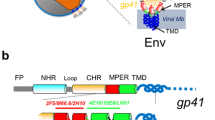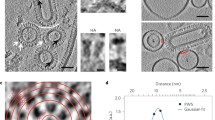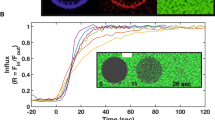Summary
The fusion of lipid enveloped viruses with cellular membranes is thought to be mediated by the insertion into the target membrane of the N-terminal polypeptides of viral spike glycoproteins. Since membrane destabilization is a necessary step in membrane fusion, we investigated whether synthetic peptides with amino acid sequences corresponding to the N-termini of influenza virus hemagglutinin (HA2), vesicular stomatitis virus G-protein and Sendai virus F-protein, induce the destabilization and fusion of phospholipid vesicles. Membrane destabilization by the peptides was monitored by the release of aqueous contents of large unilamellar phospholipid vesicles. Aggregation was detected by a resonance energy transfer assay. Membrane fusion was followed by means of assays for the intermixing of phospholipids and of aqueous contents. The 17-amino acid HA2 peptide (HA2.17) destabilized phosphatidylcholine (PC) vesicles even at neutral pH, but the rate and extent of destabilization increased at lower pH. This peptide did not mediate appreciable release of contents from phosphatidylserine (PS) vesicles. HA2.17 induced neither aggregation nor fusion of PC or PS vesicles. In contrast, the 7-amino acid N-terminal peptide of G-protein (G.7) destabilized PS-containing membranes and not pure PC vesicles. Although G.7 caused aggregation of and lipid mixing between PS vesicles, it did not mediate any detectable intermixing of aqueous contents. The presence of cholesterol in PC membranes did not affect the destabilization caused by the N-terminal peptide of Sendai virus F-protein (F1.7), suggesting that cholesterol is not necessary for the effective interaction of this peptide with membranes, contrary to earlier proposals. Our results support the hypothesis that the hydrophobic N-terminal region of certain viral envelope proteins insert into and destabilize target membranes.
Similar content being viewed by others
References
Amselem, S., Barenholz, Y., Loyter, A., Nir, S., Lichtenberg, D. 1986. Fusion of Sendai virus with negatively charged liposomes as studied by pyrene-labelled phospholipid liposomes. Biochim. Biophys. Acta 860:301–313
Asano, K., Asano, A. 1985. Why is a specific amino acid sequence of F glycoprotein required for the membrane fusion reaction between envelope of HVJ (Sendai virus) and target cell membranes? Biochem. Int. 10:115–122
Asano, K., Murachi, T., Asano, A. 1983. Structural requirements for hemolytic activity of F-glycoprotein of HVJ (Sendai virus) studied by proteolytic digestion. J. Biochem. 93:733–741
Bartlett, G.R. 1959. Phosphorus assay in column chromatography. J. Biol. Chem. 234:466–468
Burger, K.N.J., Wharton, S.A., Demel, R.A., Verkleij, A.J. 1991. The interaction of synthetic analogs of the N-terminal fusion sequence of influenza virus with a lipid monolayer. Comparison of fusion-active and fusion-defective analogs. Biochim. Biophys. Acta 1065:121–129
Chernomordik, L.V., Melikyan, G.B., Chizmadzhev, Y.A. 1987. Biomembrane fusion: A new concept derived from model studies using two interacting planar lipid bilayers. Biochim. Biophys. Acta 906:309–352
Citovsky, V., Blumenthal, R., Loyter, A. 1985. Fusion of Sendai virions with phosphatidylcholine-cholesterol liposomes refleets the viral activity required for fusion with biological membranes. FEBS Lett. 193:135–140
Doms, R.W., Helenius, A., White, J. 1985. Membrane fusion activity of the influenza hemagglutinin. The low pH-induced conformational change. J. Biol. Chem. 260:2973–2981
Düzgüneş, N. 1985. Membrane fusion. In: Subcellular Biochemistry. D.B. Roodyn, editor. Vol. 11, pp. 195–286. Plenum, London
Düzgüneş, N., 1988. Cholesterol and membrane fusion. In: Biology of Cholesterol. P.L. Yeagle, editor, pp. 197–212. CRC Press, Boca Raton (FL)
Düzgüneş, N., Allen, T.M., Fedor, J., Papahadjopoulos, D. 1987. Lipid mixing during membrane aggregation and fusion. Why fusion assays disagree. Biochemistry 26:8435–8442
Düzgüneş, N., Bentz, J. 1988. Fluorescence assays for membrane fusion. In: Spectroscopic Membrane Probes. L.M. Loew, editor, pp. 117–159. CRC Press, Boca Raton (FL)
Düzgüneş, N., Gambale, F. 1988. Membrane action of synthetic peptides from influenza virus hemagglutinin and its mutants. FEBS Lett. 227:110–114
Düzgüneş, N., Shavnin, S.A. 1988. Influence of synthetic peptides derived from viral envelope proteins on the permeability and fusion of phospholipid vesicles. Abstr. Frumkin Symposium on Bioelectrochemistry, Suzdal, USSR
Düzgüneş, N., Straubinger, R.M., Baldwin, P.A., Friend, D.S., Papahadjopoulos, D. 1985. Proton-induced fusion of oleic acid/phosphatidylethanolamine liposomes. Biochemistry 24:3091–3098
Düzgüneş, N., Wilschut, J., Hong, K., Fraley, R., Perry, C., Friend, D.S., James, T.L., Papahadjopoulos, D. 1983. Physicochemical characterization of large unilamellar vesicles prepared by reverse-phase evaporation. Biochim. Biophys. Acta 732:289–299
Eisenberg, D., Schwarz, E., Komoramy, M., Wall, R. 1984. Analysis of membrane and surface protein sequences with the hydrophobic moment plot. J. Mol. Biol. 179:125–142
Ellens, H., Bentz, J., Szoka, F.C. 1984. pH-induced destabilization of phosphatidylethanolamine-containing liposomes. Biochemistry 23:1532–1538
Ellens, H., Bentz, J., Szoka, F.C. 1985. H+ and Ca2+-induced fusion and destabilization of liposomes. Biochemistry 24:3099–3106
Geisow, M.J., Fritsche, V., Hexham, J.M., Dash, B., Johnson, T. 1986. A consensus amino-acid sequence repeat in Torpedo and mammalian Ca2+-dependent membrane-binding proteins. Nature 320:636–638
Gething, M.-J., Doms, R.W., York, D., White, J.M. 1986. Studies on the mechanism of membrane fusion: Site-specific mutagenesis of the hemagglutinin of influenza virus. J. Cell Biol. 102:11–23
Gething, M.J., White, J.M., Waterfield, M.D. 1978. Purification of the fusion protein of Sendai virus: Analysis of the NH2terminal sequence generated during precursor activation. Proc. Natl. Acad. Sci. USA 75:2737–2740
Harter, C., James, P., Bächi, T., Semenza, G., Brunner, J. 1989. Hydrophobic binding of the ectodomain of influenza hemagglutinin to membranes occurs through the “fusion peptide.” J. Biol. Chem. 264:6459–6464
Hoekstra, D. 1982. Kinetics of intermixing of lipids and mixing of aqueous contents during vesicle fusion. Biochim. Biophys. Acta 692:171–175
Hoekstra, D. 1990. Membrane fusion of enveloped viruses: Especially a matter of proteins. J. Bioenerg. Biomembr. 22:121–156
Hoekstra, D., Kok, J.W. 1989. Entry mechanisms of enveloped viruses. Implications for fusion of intracellular membranes. Biosci. Rep. 9:273–305
Hoekstra, D., Wilschut, J. 1989. Membrane fusion of artificial and biological membranes: Role of local membrane dehydration. In: Water Transport in Biological Membranes. G. Benga, editor, pp. 143–176. CRC Press, Boca Raton (FL)
Hoyt, D.W., Gierasch, L.M. 1991. Hydrophobic content and lipid interactions of wild-type and mutant OmpA signal peptides correlate with their in vivo function. Biochemistry 30:10155–10163
Hsu, M.C., Scheid, A., Choppin, P.W. 1981. Activation of the Sendai virus fusion protein (F) involves a conformational change with exposure of a new hydrophobic region. J. Biol. Chem. 256:3557–3563
Kelsey, D.R., Flanagan, T.D., Young, J., Yeagle, P.L. 1990. Peptide inhibitors of enveloped virus infection inhibit phospholipid vesicle fusion and Sendai virus fusion with phospholipid vesicles. J. Biol. Chem. 265:12178–12183
Killian, J.A., de Jong, A.M.P., Bijvelt, J., Verkleij, A.J., de Kruijff, B. 1990. Induction of non-bilayer lipid structures by functional signal peptides. EMBO J. 9:815–819
Klappe, K., Wilschut, J., Nir, S., Hoekstra, D. 1986. Parameters affecting fusion between Sendai virus and liposomes. Role of viral proteins liposome composition and pH. Biochemistry 25:8252–8260
Kowalski, M., Potz, J., Basiripour, L., Dorfman, T., Goh, W.C., Terwilliger, E., Dayton, A., Rosen, C., Haseltine, W., Sodroski, J. 1987. Functional regions of the envelope glycoprotein of human immunodeficiency virus type 1. Science 237:1351–1355
Lear, J.D., De Grado, W.F. 1987. Membrane binding and conformational properties of peptides representing the NH2 terminus of influenza virus. J. Biol. Chem. 262:6500–6505
Leikin, S.L., Kozlov, M.M., Chernomordik, L.V., Markin, V.S., Chizmadzhev, Y.A. 1987. Membrane fusion: Overcoming the hydration barrier and local restructuring. J. Theor. Biol. 129:411–425
Marsh, M., Helenius, A. 1989. Virus entry into animal cells. Adv. Virus Res. 36:107–151
Murata, M., Sugahara, Y., Takahashi, S., Ohnishi, S.-I. 1987. pH-Dependent membrane fusion activity of a synthetic twenty amino acid peptide with the same sequence as that of the hydrophobic segment of influenza virus hemagglutinin. J. Biochem. 102:957–962
Nir, S., Klappe, K., Hoekstra, D. 1986. Mass action analysis of kinetics and extent of fusion between Sendai virus and liposomes. Biochemistry 25:8261–8266
Norrby, E. 1971. The effect of a carbobenzoxy tripeptide on the biological activities of measles virus. Virology 44:599–608
Novick, S.L., Hoekstra, D. 1988. Membrane penetration of Sendai virus glycoproteins during the early stages of fusion with liposomes as determined by hydrophobic photoaffinity labeling. Proc. Natl. Acad. Sci. USA 85:7433–7437
Ohki, S. 1988. Surface tension, hydration energy and membrane fusion. In: Molecular Mechanisms of Membrane Fusion. S. Ohki, D. Doyle, T.D. Flanagan, S.K. Hui, and E. Mayhew, editors, pp. 123–138. Plenum, New York
Ohki, S., Düzgüneş, N. 1979. Divalent cation-induced interaction of phospholipid vesicles and monolayer membranes. Biochim. Biophys. Acta 552:438–449
Ohnishi, S. 1988. Fusion of viral envelopes with cellular membranes. In: Membrane Fusion in Fertilization, Cellular Transport and Viral Infection. N. Düzgüneş and F. Bronner, editors, pp. 257–296. Academic, New York
Okada, Y. 1988. Sendai virus-mediated cell fusion. In: Membrane Fusion in Fertilization, Cellular Transport and Viral Infection. N. Düzgüneş and F. Bronner, editors, pp. 297–336. Academic, New York
Parente, R.A., Nir, S., Szoka, F.C., Jr. 1988. pH-dependent fusion of phosphatidylcholine small vesicles. J. Biol. Chem. 263:4724–4730
Parente, R.A., Nir, S., Szoka, F.C., Jr. 1990. Mechanism of leakage of phospholipid vesicle contents induced by the peptide GALA. Biochemistry 29:8720–8728
Pedroso de Lima, M.C., Nir, S., Flasher, D., Klappe, K., Hoekstra, D., Düzgüneş, N. 1991. Fusion of Sendai virus with human HL-60 and CEM cells: Different kinetics of fusion for two isolates. Biochim. Biophys. Acta 1070:446–454
Puri, A., Booy, F.P., Doms, R.W., White, J.M., Blumenthal, R. 1990. Conformational changes and fusion activity of influenza virus hemagglutinin of the H2 and H3 subtypes: Effects of acid pretreatment. J. Virol. 64:3824–3832
Rafalski, M., Ortiz, A., Rockwell, A., van Ginkel, L.C., Lear, J.D., DeGrado, W.F., Wilschut, J. 1991. Membrane fusion activity of the influenza virus hemagglutinin: Interaction of HA2 N-terminal peptides with phospholipid vesicles. BioChemistry 30:10211–10220
Richardson, C.D., Scheid, A., Choppin, P.W. 1980. Specific inhibition of paramyxovirus and myxovirus replication by oligopeptides with amino acid sequences similar to those at the N-termini of the F1 or HA2 viral polypeptides. Virology 105:205–222
Rosenberg, J., Düzgüneş, N., Kayalar, C. 1983. Comparison of two liposome fusion assays monitoring the intermixing of aqueous contents and of membrane components. Biochim. Biophys. Acta 735:173–180
Ruigrok, R.W.H., Wrigley, N.G., Calder, L.J., Cusak, S., Wharton, S.A., Brown, E.B., Skehel, J.J. 1986. Electron microscopy of the low pH structure of influenza virus hemagglutinin. EMBO J. 5:41–49
Sato, S.B., Kawasaki, K., Ohnishi, S.-I. 1983. Hemolytic activity of influenza virus hemagglutinin glycoproteins activated in mildly acidic environments. Proc. Natl. Acad. Sci. USA 80:3153–3157
Schlegel, R., Tralka, S.T., Willingham, M.C., Pastan, I. 1983. Inhibition of VSV binding and infectivity by phosphatidylserine: Is phosphatidylserine a VSV binding site? Cell 32:639–646
Schlegel, R., Wade, M. 1984a. Biologically active peptides of the vesicular stomatitis virus glycoprotein. J. Virol. 53:319–323
Schlegel, R., Wade, M. 1984b. A synthetic peptide corresponding to the NH2 terminus of vesicular stomatitis virus glycoprotein is a pH-dependent hemolysin. J. Biol. Chem. 259:4691–4694
Shiffer, K., Hawgood, S., Düzgünes, N., Goerke, J. 1988. The interactions of the low molecular weight group of surfactantassociated proteins (SP 5–18) with pulmonary surfactant lipids. Biochemistry 27:2689–2695
Skehel, J.J., Bayley, P.M., Brown, E.B., Martin, S.R., Waterfield, M.D., White, J.M., Wilson, I.A., Wiley, D.C. 1982. Changes in the conformation of influenza hemagglutinin at the pH optimum of virus mediated membrane fusion. Proc. Natl. Acad. Sci. USA 79:968–972
Spear, P.G. 1987. Virus-induced cell fusion. In: Cell Fusion. A.E. Sowers, editor, pp. 3–32. Plenum, New York
Stegmann, T., Doms, R.W., Helenius, A. 1989. Protein-mediated membrane fusion. Annu. Rev. Biophys. Chem. 18:187–211
Stegmann, T., Hoekstra, D., Scherphof, G., Wilschut, J. 1986. Fusion activity of influenza virus. A comparison between biological and artificial target membrane vesicles. J. Biol. Chem. 261:10966–10969
Struck, D.K., Hoekstra, D., Pagano, R.E. 1981. Use of resonance energy transfer to monitor fusion. Biochemistry 20:4093–4099
Subbarao, N.K., Parente, R.A., Szoka, F.C., Jr., Nadasdi, L., Pongracz, K. 1987. pH-dependent bilayer destabilization by an amphipathic peptide. Biochemistry 26:2964–2972
Suenaga, M., Lee, S., Park, N.G., Aoyagi, H., Kato, T., Umeda, A., Amako, K. 1989. Basic amphipathic helical peptides induce destabilization and fusion of acidic and neutral liposomes. Biochim. Biophys. Acta 981:143–150
Szoka, F., Olson, F., Heath, T., Vail, W., Mayhew, E., Papahadjopoulos, D. 1980. Preparation of unilamellar liposomes of intermediate size (0.1–0.2 μm) by a combination of reverse phase evaporation and extrusion through polycarbonate membranes. Biochim. Biophys. Acta 601:559–571
Wharton, S.A., Martin, S.R., Ruigrok, R.W.H., Skehel, J.J., Wiley, D.C. 1988. Membrane fusion by peptide analogues of influenza virus hemagglutinin. J. Gen. Virol. 69:1847–1857
White, J., Kielian, M., Helenius, A. 1983. Membrane fusion proteins of enveloped animal viruses. Q. Rev. Biophys. 16:151–195
White, J.M., Wilson, I.A. 1987. Anti-peptide antibodies detect steps in a protein conformational change: Low pH activation of the influenza virus hemagglutinin. J. Cell Biol. 105:2887–2896
Wilschut, J., Düzgüneş, N., Papahadjopoulos, D. 1981. Calcium/magnesium specificity in membrane fusion: Kinetics of aggregation and fusion of phosphatidylserine vesicles and the role of bilayer curvature. Biochemistry 20:3126–3133
Woodget, C., Rose, J.K. 1986. Amino-terminal mutation of the vesicular stomatitis virus glycoprotein does not affect its fusion activity. J. Virol. 59:486–489
Yeagle, P.L., Epand, R.M., Richardson, C.D., Flanagan, T.D. 1991. Effects of the ‘fusion peptide’ from measles virus on the structure of N-methyl dioleoylphosphatidyl-ethanolamine membranes and their fusion with Sendai virus. Biochim. Biophys. Acta 1065:49–53
Author information
Authors and Affiliations
Additional information
This work was supported by NIH Grant AI25534 (N.D.), US-Israel Binational Science Foundation Grant 86-00010 (S. Nir & N.D.), and grants from the UCSF School of Medicine (MSC-25) and Academic Senate (N.D.). Dr. S. Shavnin was the recipient of an International Research & Exchanges Board (IREX) Fellowship. We thank Mr. Dennis Alford for technical assistance and Dr. D. Papahadjopoulos (UCSF) for discussions and the use of his laboratory facilities. We are indebted to Dr. S. Nir (Hebrew University of Jerusalem and University of the Pacific) for many helpful discussions and comments on the manuscript.
Rights and permissions
About this article
Cite this article
Düzgüneş, N., Shavnin, S.A. Membrane destabilization by N-terminal peptides of viral envelope proteins. J. Membarin Biol. 128, 71–80 (1992). https://doi.org/10.1007/BF00231872
Received:
Revised:
Issue Date:
DOI: https://doi.org/10.1007/BF00231872




